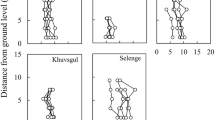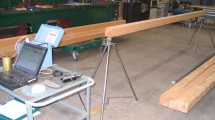Abstract
According to NLGA standard grading rules, the dimension lumber of plantation Chinese fir was graded into four grades, i.e. SS, No. 1, No. 2 and No. 3. The bending strength and stiffness were determined according to ASTM D4761-05. The results showed that there was a significant difference in both MOE and MOR of the lumber with and without pith for SS and No. 2 grades, but this was not the case for No. 3 grade lumber. The mean MOE and MOR decreased as growth ring width (GRW) of each graded lumber increased. MOR and MOE of the SS and No. 2 grade dimension lumber with GRW<6 mm were significantly different from that of GRW≥6 mm group. In regard to plantation Chinese fir, it is suggested that No. 2 and better grades should not have pith and the GRW must be less than 6 mm. For the lumber with pith and GRW≥6 mm, it should be graded into No. 3 grade.
Zusammenfassung
Tannenschnittholz aus Plantagenbeständen wurde gemäß den NLGA Sortierregeln in die vier Sortierklassen SS, No. 1, No. 2 und No. 3 eingestuft und die Biegefestigkeit und der E-Modul wurden gemäß ASTM D4761-05 bestimmt. Die Ergebnisse zeigten, dass sich in den Sortierklassen SS und No. 2 die Biegefestigkeit und der Elastizitätsmodul von Schnittholz mit und Holz ohne Markröhre signifikant unterschieden. Dies traf jedoch auf Holz der Sortierklasse No. 3 nicht zu. Der mittlere E-Modul und die mittlere Biegefestigkeit nahmen mit zunehmender Jahrringbreite (GRW) in jeder Sortierklasse ab. In den Sortierklassen SS und No. 2 unterschieden sich der E-Modul und die Biegefestigkeit von Schnittholz mit einer Jahrringbreite <6 mm signifikant von Schnittholz mit einer Jahrringbreite ≥6 mm. Für Tannenholz aus Plantagenbeständen wird empfohlen, dass die Klassen No. 2 und besser keine Markröhre aufweisen und die Jahrringbreite unter 6 mm liegen sollte. Schnittholz mit Markröhre und einer Jahrringbreite ≥6 mm sollte in die Sortierklasse No. 3 eingestuft werden.

Similar content being viewed by others
References
American Society for Testing and Materials D 1990-00 (2006) Standard practice for establishing allowable properties for visually-graded dimension lumber from in-grade test of full-size specimens 4(10):535–544
American Society for Testing and Materials D 4761-05 (2006) Standard test methods for mechanical properties of lumber and wood-base structural material 4(10):535–544
Bao F, Jiang Z (1998) Wood properties of main tree species from plantation China. China Forestry Publishing House, Beijing
Barrett JD, Kellogg RM (1991) Bending strength and stiffness of second-growth Douglas-fir dimension lumber. For Prod J 41(10):35–43
Barrett JD, Lau W (1994) Canadian lumber properties, Canadian wood council
British standard, BS 4978 (2007) Visual strength grading of softwood. London, United Kingdom British Standards Institution
China State Bureau of Technical Supervision GB1933-91 (1991) Method for determination of the density of wood. Standards press of China, Beijing
Dunham RA, Cameron AD, Petty JA (1999) The effect of growth rate on the strength properties of sawn beams of silver birch. Scand J For Res 14:18–26
Kretschmann DE, Evans JW (1999) Monitoring of visually graded structural lumber. Forest Products Laboratory, United States Department of Agriculture
Moberg L (2000) Models of internal knot diameter for Pinus sylvestris. Scand J For Res 15:177–187
National lumber grades authority (NLGA) (2003) Standard grading rules for Canadian lumber. NLGA, British Columbia, Canada, pp 70–75, 182–183
Acknowledgements
The author extends gratitude to Prof. Xiuqin Luo and Dr. Yafang Yin for their support of this study. Parts of this work were financially supported by machining and processing technology of constructional lumber supported by key project of Ministry of Science and Technology (2006BAD18B07).
Author information
Authors and Affiliations
Corresponding author
Rights and permissions
About this article
Cite this article
Jiang, J., Lu, J., Ren, H. et al. Effect of growth ring width, pith and visual grade on bending properties of Chinese fir plantation dimension lumber. Eur. J. Wood Prod. 70, 119–123 (2012). https://doi.org/10.1007/s00107-011-0529-z
Received:
Published:
Issue Date:
DOI: https://doi.org/10.1007/s00107-011-0529-z




